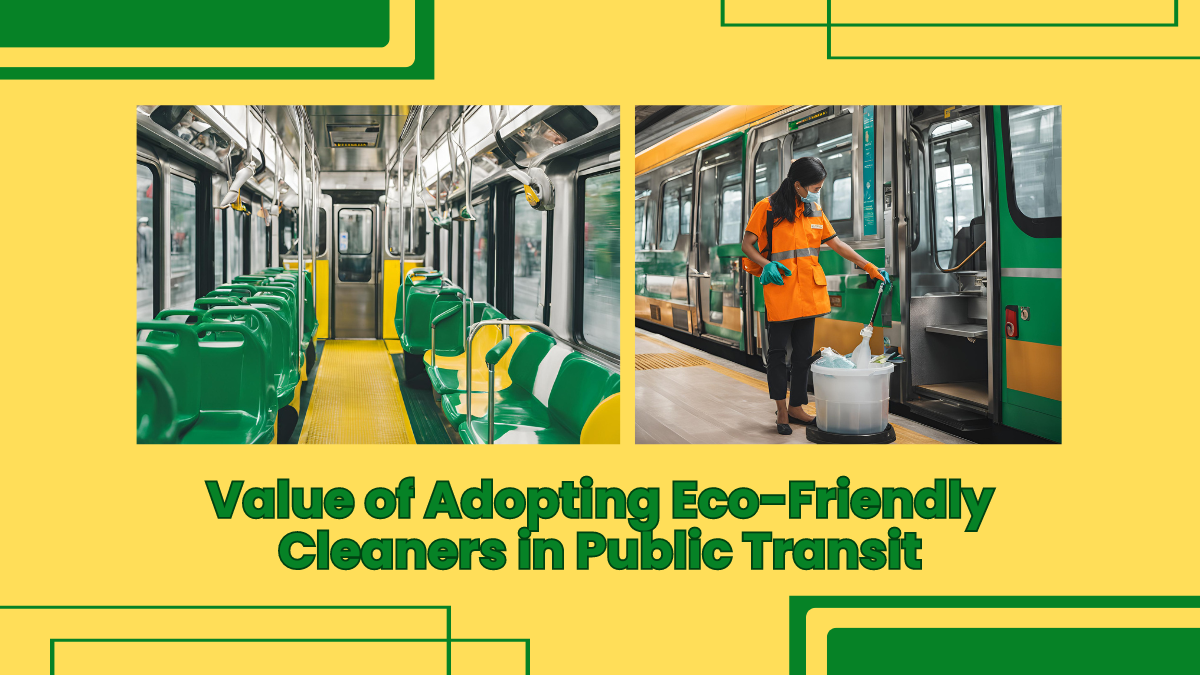Introduction to the Value of Adopting Eco-Friendly Cleaners in Public Transit
Public transit systems are the backbone of urban mobility, moving millions of people daily. Cleanliness in these systems is paramount for aesthetic reasons, health, and safety. Enter eco-friendly cleaners, a revolutionary approach to sustainably maintaining hygiene. We’ll explore the value of adopting eco-friendly cleaners in public transit, their benefits, and practical implementation strategies. Eco-Friendly Cleaners in Public Transit are cleaning products designed with minimal environmental impact in mind. They are typically made from natural, biodegradable ingredients that do not harm the ecosystem. Common ingredients include plant-based solvents, essential oils, and non-toxic surfactants.
Environmental Benefits of Eco-Friendly Cleaners in Public Transit
Using eco-friendly cleaners in public transit significantly reduces pollution. Traditional cleaners often contain harsh chemicals that can leach into waterways and soil, causing environmental damage. Eco-friendly alternatives, on the other hand, break down naturally and do not contribute to long-term pollution. Additionally, these cleaners typically have a lower carbon footprint, requiring less energy and resources to produce.
Health Benefits for Passengers and Workers
Switching to eco-friendly cleaners also offers substantial health benefits. Traditional cleaners can release volatile organic compounds (VOCs) that degrade air quality and pose health risks. Eco-friendly cleaners reduce passengers’ and transit workers’ exposure to these harmful chemicals, improving air quality and reducing allergic reactions or respiratory issues.
Economic Advantages of Eco-Friendly Cleaners in Public Transit
While the initial cost of eco-friendly cleaners might be higher, they are often more cost-effective in the long run. They can lead to savings through reduced healthcare costs for workers and fewer sick days. Additionally, some governments offer incentives for using environmentally friendly products, providing further financial benefits.
Successful Implementation of Eco-Friendly Cleaners in Public Transit
City A’s transit authority switched to eco-friendly cleaners and saw a noticeable reduction in its environmental impact. The water quality near transit facilities improved, and less chemical residue was detected in the surrounding soil.
Improved Passenger Satisfaction
In City B, passenger satisfaction surveys indicated a positive response to the switch, with many noting the fresher, more pleasant environment in transit stations and vehicles.
Cost Savings Analysis
City C’s analysis showed significant long-term savings in operational costs, mainly due to lower healthcare expenses and reduced need for protective equipment for cleaning staff.
Challenges and Solutions in Implementing Eco-Friendly Cleaners in Public Transit
Initial Cost and Budget Constraints
One of the main challenges is the initial cost. However, this can be mitigated by gradually phasing in eco-friendly products and taking advantage of bulk purchasing discounts.
Training and Education for Staff
Proper training and education are crucial. Staff need to understand how to use new products effectively, which can be achieved through comprehensive training programs.
Overcoming Resistance to Change
Resistance to change is natural. To gain their buy-in, the long-term benefits must be clearly communicated, and staff must be incorporated into the transition process.
Types of Eco-Friendly Cleaners Suitable for Public Transit
Cleaning Calls Eco-Green All Glass Cleaner
Glasses are meant to shine and gloss. Researchers at Ecochem offer all types of glass cleansing and care solutions with the handy Green-All Glass Cleanser. It leaves surfaces shiny and acts softly on scratches, leaving the glass and stainless steel polished and stain-free, as it is formulated using water-based techniques. Our biodegradable cleaning chemicals provide the best solutions to the surface by disinfecting it from microbes and bacteria.
Cleaning Calls For Eco-Green Kleen Eraser For Stain Remover
Eco-Green Kleen eraser is an Eco-friendly Paan/gutka/Ink Stain remover formulated to erase tough stains from industrial walls, grills, and corners. With a population of gutka chewers and paan consumers, a solution is necessary. With our sharp eyes on relevant green chemicals, our researchers have created this natural, green, herbal, and organic cleaning chemical.
Sanitize Your Hand With Eco-Grenitizer!
Ecochem understands the urban lifestyle and the need for quick sanitizer. A healthy and disease-free lifestyle requires a disinfectant right at the availability of the disinfectant to kill germs and make hands germ-free. Eco-Grenitizer is one of the premium products specially formulated for pharmaceuticals, processed industries, corporations, etc.
Comparing Traditional Cleaners to Eco-Friendly Alternatives
Eco-friendly cleaners differ significantly from traditional cleaners regarding chemical composition and environmental impact. While traditional cleaners often contain synthetic chemicals, eco-friendly alternatives use natural ingredients that are safer for the environment. Additionally, eco-friendly cleaners are just as effective, if not more so, than their traditional counterparts, proving that sustainability doesn’t compromise cleanliness.
How Eco-Friendly Cleaners in Public Transit Enhance Public Perception
Adopting eco-friendly cleaners can significantly enhance the public perception of a transit system. It signals a commitment to sustainability and can attract eco-conscious passengers. Moreover, positive media coverage and public relations benefits can arise from such green initiatives, further boosting the transit system’s reputation.
Steps to Transition to Eco-Friendly Cleaners
Assessing Current Cleaning Practices
Begin by evaluating the current cleaning products and methods used.
Researching Eco-Friendly Products
Identify and test eco-friendly alternatives to ensure they meet the required cleanliness and safety standards.
Gradual Implementation
Introduce eco-friendly cleaners gradually to manage costs and allow time for staff training and adjustment.
Regulatory Support and Guidelines
Government policies and industry standards often support the use of eco-friendly products. Many regions offer certifications and labels that can guide the selection of appropriate products, ensuring they meet environmental and safety standards.
The Role of Technology in Eco-Friendly Cleaning
Advancements in technology have led to innovations in eco-friendly cleaning products and methods. Innovative cleaning systems can optimize the use of these products, ensuring efficient and effective cleaning while minimizing waste.
Future Trends in Eco-Friendly Cleaning for Public Transit
The future of eco-friendly cleaning in public transit looks promising, with new products and practices continually emerging. As technology advances, we can expect even more efficient and sustainable cleaning solutions to become available, further reducing the environmental impact of public transit systems.
Conclusion on Eco-Friendly Cleaners in Public Transit
Adopting eco-friendly cleaners in public transit offers numerous benefits, from environmental and health improvements to economic savings and enhanced public perception. As we move towards a more sustainable future, public transit systems must embrace these green alternatives. By doing so, they can contribute to a healthier planet while providing a cleaner, safer environment for passengers and workers alike.
FAQs on Eco-Friendly Cleaners in Public Transit
What are eco-friendly cleaners?
Eco-friendly cleaners are natural, biodegradable ingredients designed to minimize environmental impact.
How do eco-friendly cleaners benefit public health?
They reduce exposure to harmful chemicals, improve air quality, and reduce allergic reactions and respiratory issues.
Are eco-friendly cleaners more expensive?
While they may have a higher initial cost, eco-friendly cleaners are often more cost-effective in the long run due to savings on health care costs and potential government incentives.
What are the challenges in switching to eco-friendly cleaners?
Challenges include initial cost, staff training, and overcoming resistance to change. These can be addressed through gradual implementation and comprehensive education.
How can public transit systems start using eco-friendly cleaners?
Transit systems can start by assessing current cleaning practices, researching eco-friendly products, and implementing changes gradually while training staff.
Written by: Anshika


